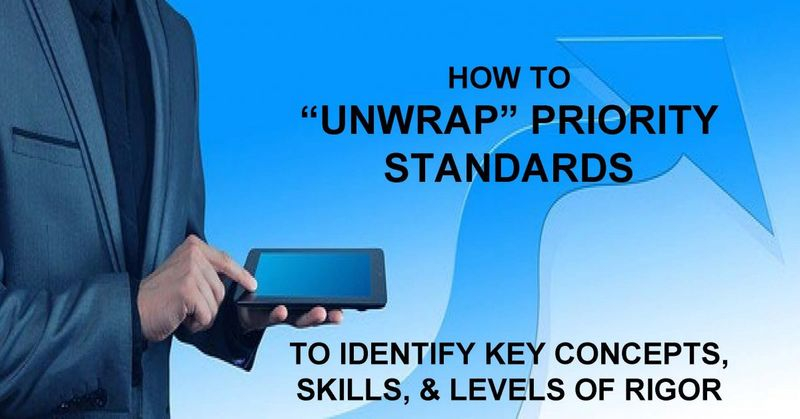Date of Blog Post: March 9, 2022
Newly Republished on Amazon KDP! “Unwrapping” Common Core State Standards: Deconstructing Priority Standards to Identify Levels of Rigor, Big Ideas, and Essential Questions (Ainsworth, 2022)
Amazon Link to Book: https://tinyurl.com/yzs9mxwb
IMPORTANT NOTE TO READERS:
My newly republished book specifically addresses how to “unwrap” the Common Core State Standards in both English language arts and mathematics. However, why the “unwrapping” of standards is a powerful method for clearly understanding the standards, and how educators can “unwrap” their own state standards in any grade, course, and content area, are directly relevant and applicable to ALL state standards—not to the Common Core only.
Through explanations and examples, you’ll learn how to:
- Clarify specific concepts and skills that students need to know and be able to do from the wording of the Priority Standards;
- Identify the levels of thinking-skill rigor in the Priority Standards in order to directly match assessment questions to those levels of rigor;
- Determine Big Ideas (the aha’s or “lightbulb” moments of understanding) you want your students to discover as they learn the “unwrapped” standards; and
- Write Essential Questions that engage students and lead them to their own discovery of the Big Ideas.
- BONUS: See 60 examples of “unwrapped” English language arts and math standards with Big Ideas and Essential Questions specific to K-2, 3-5, 6-8, and 9-12 grade bands!
The power of the “unwrapping” standards process, proven by educators and leaders in school systems across North America over the last 21 years, lies in the doing, in the experience of the process. As you fully engage in this simple-to-follow procedure, you will discover for yourself the truth of these words!
****************************************************************************
In addition to the voluminous numbers of standards teachers must impart to their students each year, there is the added challenge of really understanding what the standards means. It’s one thing to read a standard and get a general sense of what it’s about. It’s another thing to thoroughly understand what it explicitly and implicitly indicates. What is it that students must know and be able to do as stated in each of these learning outcomes?
“Unwrapping” is a simple method that all teachers in all grade levels and courses can use to deconstruct the wording of any standard in order to know its meaning inside and out.
Why is this important? If teachers aren’t crystal clear about the concepts and skills in a given standard, how can they accurately teach it? How can they accurately assess student understanding of it? How can they clearly communicate to students the specific learning targets?
“Unwrapping” the Priority Standards (those rigorous standards pre-determined by teachers that will require in-depth instructional focus) is the first important step in planning effective instruction and assessment of those Priority Standards.
Why is this important? If teachers aren’t crystal clear about the concepts and skills in a given standard, how can they accurately teach it? How can they accurately assess student understanding of it? How can they clearly communicate to students the specific learning targets?
“Unwrapping” the Priority Standards (those rigorous standards pre-determined by teachers that will require in-depth instructional focus) is the first important step in planning effective instruction and assessment of those Priority Standards.
How to “Unwrap” for Greater Clarity
Working alone or with colleagues, educators examine each Priority Standard they will teach to their students during a series of related lessons or a unit of study. They underline the teachable concepts (important nouns and noun phrases) and CAPITALIZE the skills (verbs) that students are to demonstrate. Some of these concepts and skills represent surface or simple learning (lower-level foundational knowledge and procedures); others represent deeper or abstract understanding (higher-level insights and applications). Together, these “unwrapped” concepts and skills represent what students need to know and be able to do to learn the Priority Standard in focus.
Create a Graphic Organizer
After the “unwrapping” step is completed, teachers next prepare a graphic organizer (outline, bulleted list, concept map, or chart) as a visual display of the “unwrapped” concepts and skills. They then determine each skill’s approximate level of rigor using the Revised Bloom’s Taxonomy and/or Webb’s Depth of Knowledge (DOK).
Here’s the major benefit for doing this: Teachers will be able to accurately match the rigor of the “unwrapped” Priority Standard to the rigor of assessment questions, either in the selected-response format (multiple-select, matching, true-false) and/or the constructed-response format. This is a powerful way to gain credible assessment evidence of student learning of those standards.
My highly recommended, go-to resource for determining the rigor of an “unwrapped” Priority Standard is a collection of Cognitive Rigor Matrices in different content areas created by Dr. Karin Hess, that she has made available online free of charge at Karin Hess
Not Just “Word Shuffling”
Transferring the underlined concepts and capitalized skills from the standards document to the graphic organizer may seem to be mere “word shuffling,” but it is much more than that. Even though the first task is to separate concepts from skills, the two remain tightly connected. It is the reorganization of the concepts and skills into the visual format of a graphic organizer that enables teachers to grasp a standard’s precise meaning and to determine its degree of cognitive challenge.
The assigning of approximate Bloom’s and DOK levels to the concept-skill pairs on the graphic organizer is a mentally stimulating (and sometimes challenging!) exercise, but one that teachers find extremely valuable. While working through the process, trust your professional judgment, and let yourself practice deciding these levels of rigor. You can do this process on your own, or collaborate with grade-level or course-level colleagues whenever possible, and “agree to disagree” while you are deciding the levels. Keep in mind that you can always revisit and revise your initial decisions later—usually during the drafting of assessment items. You are then zeroing in on what each “unwrapped” concept-skill is calling for so you can write an assessment question that directly matches it.
To see over 60 K-12 examples of “unwrapped” Priority Standards with graphic organizers and identified levels of cognitive rigor, here again is the Amazon link to the book: https://tinyurl.com/yzs9mxwb
Thanks for reading! In my follow-up blog post, you’ll learn how to write Big Ideas and Essential Questions derived from the “unwrapped” Priority Standards!
For more information about the “Unwrapping” Priority Standards virtual workshop, please click on this link, and/or email Larry at larry@larryainsworth.com.


